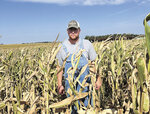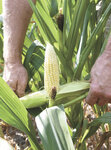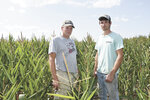


PARKER, S.D. — This summer’s drought has affected producers all across the region, leaving many with inadequate feed supplies and forcing dairy farmers to make adaptations to meet inventory needs moving into winter.
One producer who has experienced the ill effects of a lack of moisture firsthand is Lance Haase.
Haase and his father, Bruce, and uncle Dustin milk 680 head on their farm near Parker. The Haases farm 7,000 acres, 780 of which are irrigated.
“We had good soil moisture going into spring, but rain became scarce after our crops were planted,” Haase said. “The last substantial rain that we received fell on Aug. 12.”
The Haases report that corn yields on their non-irrigated land ranges anywhere from 40 bushels per acre to 100 bushels per acre. Their irrigated corn is yielding 260 bushels per acre.
Haase said the irrigated corn that was chopped for silage yielded 22 tons per acre while the non-irrigated corn yielded about 11 tons per acre.
Corn was not the only crop that suffered due to the lack of moisture this summer.
“We received just enough small showers to grow four cuttings of alfalfa,” Haase said. “The first and fourth cuttings were pretty good, but the second and third cuttings were very short. We had to buy some dry alfalfa to round out our forage supply.”
The drought is also forcing the Haases to purchase straw for calf bedding.
“None of our wheat made it through the winter due to the dry conditions, so we ripped up our wheat acres and planted them to silage corn,” Haase said. “Hardly anyone raises small grain anymore, and a lot of the wheat in our area didn’t make it. It’s been a challenge to find straw to buy.”
Bob Schyma and his family operate a 110-cow dairy near Rice, Minnesota. The Schyma family farms 300 acres that are planted to corn and alfalfa.
Their area also endured drought conditions this summer.
Schyma said they have received 3.5 inches of rain since April 16.
They planted 40 acres of peas and barley May 5. That field was chopped June 26 and yielded 20 loads.
“That was half of what we expected,” Schyma said. “We cut it again a couple weeks ago and round baled it and got 40 bales.”
Schyma got only two cuttings of alfalfa.
“We received two-tenths of rain the other night and are just hoping to get enough rain to catch the alfalfa ground for next year,” Schyma said. “We are chopping corn and are going to have to make our ration more corn based.”
The Schymas have been forced to make major changes to their harvest plans.
Schyma said they usually chop 140 acres of corn to produce enough feed, but this year, they are chopping 240 acres. In a typical year, they combine 40-60 acres as dry corn. This year, that is not an option.
“Last year, we averaged 190 bushels per acre; this year, we are going to average maybe 40 or 45,” Schyma said. “I would rather take a good crop over that crop insurance check.”
The Schyma family has noticed that good soil health can make a difference in dry years.
“The ground where we hauled manure and planted cover crops did a lot better than the ground that didn’t get any manure,” Schyma said. “Corn genetics have come a long way in recent years.”
Schyma said it took one month for a portion of the corn to germinate.
“It was the end of June before it came out of the ground,” he said. “Today, it’s as green as grass. Some of it has cobs, and some doesn’t. We are mixing it with our drier silage so it’s not too bad.”
The corn, Schyma said, is 4-6 feet tall.
“Normally, it’s as tall as the tractor cab,” he said.
Despite the drought, Schyma remains optimistic.
“We are on heavy soil, so we are doing better than the guys on sand to the west of us,” Schyma said. “We are happy to get enough silage and will use the crop insurance check to buy some corn and hay. We will make it work.”
Low crop yields are not the only concern for the Haase family.
“We go through a lot of corn stalk bales,” Haase said. “We are also concerned about soil erosion, so we won’t bale all of the stalks from the drought-stressed corn. We’ll probably bale half of the corn stalks and leave strips of stalks to help prevent erosion. I hate to see dirty snowdrifts in the ditch in the wintertime. It means that you’re losing precious topsoil.”
A simple trick has enabled the Haases to grow a fall cover crop on their land and protect it from erosion.
“We will spread oats on the land right before our manure applicator knifes in the manure,” Haase said. “The chisel plow incorporates the seed, and the manure contains enough moisture to germinate the oats. It’s an easy way to prevent the soil erosion that can be caused by our relentless winds.”
According to the U.S. Drought Monitor, the area where the Haase farm is located has been in a moderate to severe drought since the end of May.
Haase said they applied more water than usual on their irrigated acres.
“We saw a sharp uptick in water requirements during those weeks in August when the daytime temperatures hovered near 100,” he said. “Corn grows better with rainwater than with well water. Our cows felt the heat, too, but milk production remained fairly stable.”
The Haase family has learned how to cope with drought conditions.
“Dustin is in charge of the crops, and he has chosen hybrids that are more tolerant of dry weather,” Haase said. “We have also planted hybrids that are more digestible. We grind wet corn every fall, and we like corn that has kernels that shatter easily in the grinder.”
Personal stress is often an unwanted byproduct of drought. Haase has found relief by spending time with his family: wife, Brandi, and sons, Duane and Harlan.
“Spending time with my wife and our kids reminds me why we are doing all of this,” Haase said. “There is no better place to raise a family than on a dairy farm.”
Comments
No comments on this item Please log in to comment by clicking here